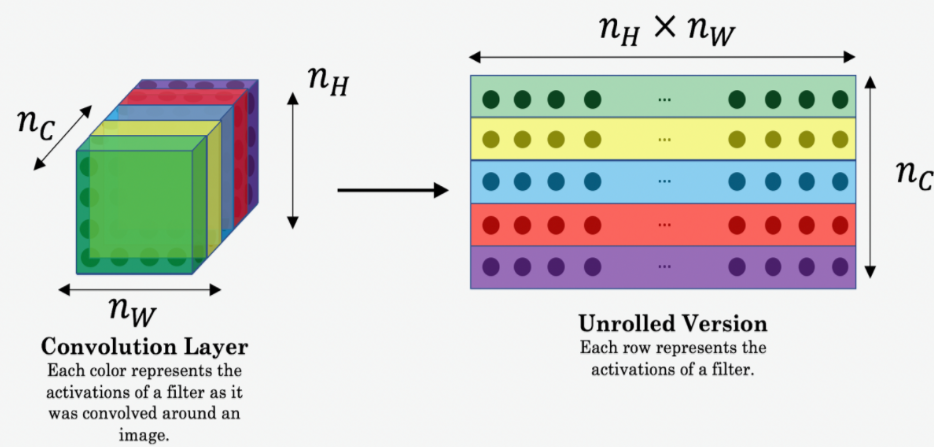项目总结四:神经风格迁移项目(Art generation with Neural Style Transfer)
1、项目介绍
神经风格转换 (NST) 是深部学习中最有趣的技术之一。它合并两个图像, 即 内容图像 C(content image) 和 样式图像S(style image), 以生成图像 G(generated image)。生成的图像 G 将图像 C 的 内容与图像S的 样式组合在一起。
2、模型
利用迁移学习的技巧,模型采用预训练的VGG19网络。预训练的模型来自 MatConvNet. http://www.vlfeat.org/matconvnet/pretrained/ 。 模型结构如下:
(1)模型结构示例图:

(2)本项目用的VGG19网络的结构
{'input': <tf.Variable 'Variable:0' shape=(1, 300, 400, 3) dtype=float32_ref>,
'conv1_1': <tf.Tensor 'Relu:0' shape=(1, 300, 400, 64) dtype=float32>,
'conv1_2': <tf.Tensor 'Relu_1:0' shape=(1, 300, 400, 64) dtype=float32>,
'avgpool1': <tf.Tensor 'AvgPool:0' shape=(1, 150, 200, 64) dtype=float32>,
'conv2_1': <tf.Tensor 'Relu_2:0' shape=(1, 150, 200, 128) dtype=float32>,
'conv2_2': <tf.Tensor 'Relu_3:0' shape=(1, 150, 200, 128) dtype=float32>,
'avgpool2': <tf.Tensor 'AvgPool_1:0' shape=(1, 75, 100, 128) dtype=float32>,
'conv3_1': <tf.Tensor 'Relu_4:0' shape=(1, 75, 100, 256) dtype=float32>,
'conv3_2': <tf.Tensor 'Relu_5:0' shape=(1, 75, 100, 256) dtype=float32>,
'conv3_3': <tf.Tensor 'Relu_6:0' shape=(1, 75, 100, 256) dtype=float32>,
'conv3_4': <tf.Tensor 'Relu_7:0' shape=(1, 75, 100, 256) dtype=float32>,
'avgpool3': <tf.Tensor 'AvgPool_2:0' shape=(1, 38, 50, 256) dtype=float32>,
'conv4_1': <tf.Tensor 'Relu_8:0' shape=(1, 38, 50, 512) dtype=float32>,
'conv4_2': <tf.Tensor 'Relu_9:0' shape=(1, 38, 50, 512) dtype=float32>,
'conv4_3': <tf.Tensor 'Relu_10:0' shape=(1, 38, 50, 512) dtype=float32>,
'conv4_4': <tf.Tensor 'Relu_11:0' shape=(1, 38, 50, 512) dtype=float32>,
'avgpool4': <tf.Tensor 'AvgPool_3:0' shape=(1, 19, 25, 512) dtype=float32>,
'conv5_1': <tf.Tensor 'Relu_12:0' shape=(1, 19, 25, 512) dtype=float32>,
'conv5_2': <tf.Tensor 'Relu_13:0' shape=(1, 19, 25, 512) dtype=float32>,
'conv5_3': <tf.Tensor 'Relu_14:0' shape=(1, 19, 25, 512) dtype=float32>,
'conv5_4': <tf.Tensor 'Relu_15:0' shape=(1, 19, 25, 512) dtype=float32>,
'avgpool5': <tf.Tensor 'AvgPool_4:0' shape=(1, 10, 13, 512) dtype=float32>}
3、成本函数
(1)内容代价函数
- 首先把图片由3D volume展开为2D matrix,如下图:

- 计算内容代价函数。分别以G和S两图片作为输入时,如果神经网络某一层的激活值相似,那么就意味着两个图片的内容相似。
![]()
(2)风格代价函数
- 首先计算某一层的Gram矩阵:

- 计算风格代价函数。分别以G和S两图片作为输入时,如果神经网络某一层的各个通道之间激活值相关系数高,那么就意味着两个图片的内容相似。
![]()
- 实际上,如果你对各层都使用风格代价函数,会让结果变得更好。计算公式如下:
![]()
- 把内容代价函数和风格代价函数组合到一起,就得到了代价函数:
![]()
4、模型优化算法与训练目标
# define optimizer (1 line) optimizer = tf.train.AdamOptimizer(2.0) # define train_step (1 line) train_step = optimizer.minimize(J)
5、输入输出数据
- 输入数据:content_image、style_image、generated_image
- 输出数据:generated_image
6、总结
- Neural Style Transfer is an algorithm that given a content image C and a style image S can generate an artistic image
- It uses representations (hidden layer activations) based on a pretrained ConvNet.
- The content cost function is computed using one hidden layer's activations.
- The style cost function for one layer is computed using the Gram matrix of that layer's activations. The overall style cost function is obtained using several hidden layers.
- Optimizing the total cost function results in synthesizing new images.



 浙公网安备 33010602011771号
浙公网安备 33010602011771号